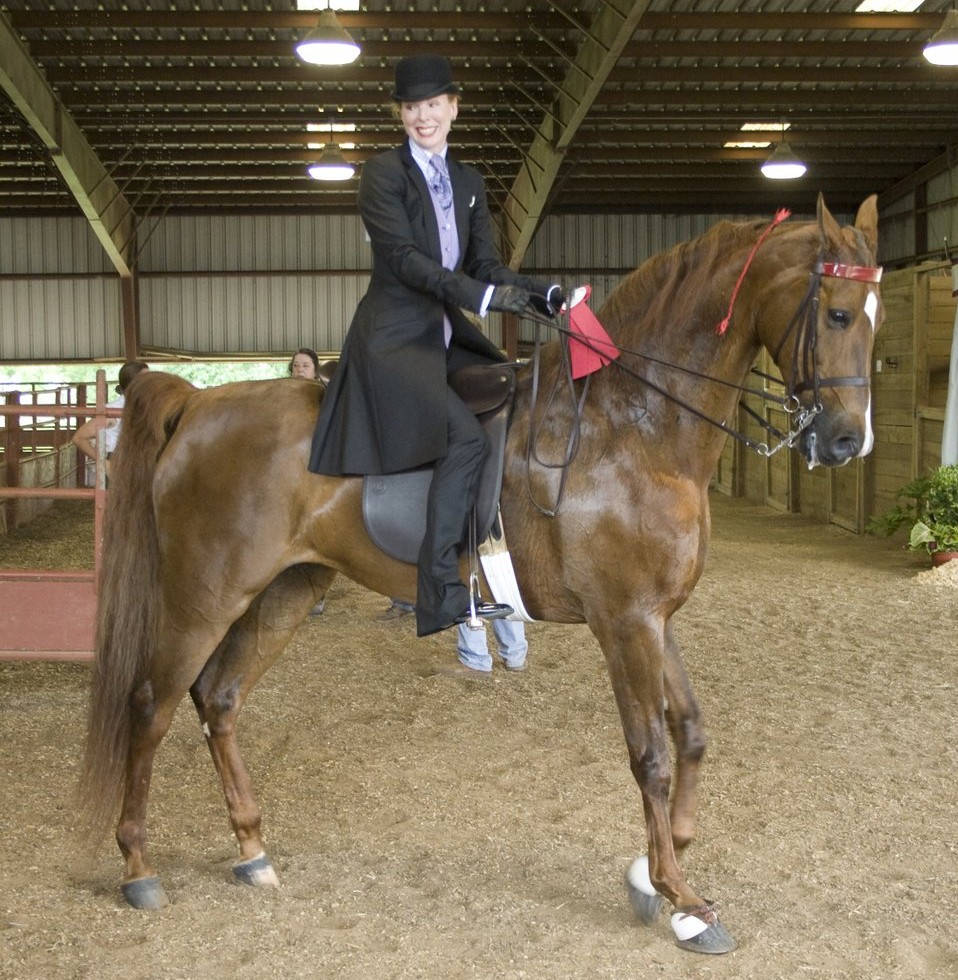American Saddlebred
|
The American Saddlebred is the epitome of the show horse. He carries himself with an attitude that eludes description—some call it "class," presence, quality, style or charm. This superior air distinguishes his every movement. The ideal American Saddlebred is well proportioned and presents a beautiful overall picture. The animal should be in good flesh, with good muscle tone and a smooth, glossy coat. Masculinity in stallions and femininity in mares are important and should be taken into consideration. The average height is 15 to 16 hands and any color is acceptable.
Gaits:
The American Saddlebred is maybe best known for its
distinctive gaits including the slow gait and the rack. The
slow gait was developed from the pace to be a four-beat gait
with each of the four feet striking the ground separately.
In the takeoff, the lateral front and hind feet start almost
together, but the hind foot contacts the ground slightly
before its lateral forefoot. The slow gait is a highly
collected gait with most of the propulsion coming from the
hindquarters, while the forequarters assist in the pull of
the final beats. The slow gait is a restrained four-beat
gait, executed slowly but with true and distinct precision.
It is high lofty, brilliant and restrained, denoting the
style, grace and polish of the horse. |
 |
The rack is a four-beat gait in which each foot meets the ground at
equal, separate intervals. It is smooth and highly animated,
performed with great action and speed, in a slightly unrestrained
manner. Desired speed and collection are determined by the maximum
rate at which a horse can rack in form. Racking in form should
include the horse remaining with a good set head. The horse should
perform it in an effortless manner from the slow gait, at which
point all strides become equally rapid and regular.
History:
In the 1600's British colonists developed the Narragansett Pacer
here in America.
When the Thoroughbreds made their first appearance in North American
during the 1700's, the colonists bred them to the Narragansett
Pacer. Through this cross the "American Horse" was developed into a
distinct horse type.
In 1776 the first documentation of the American Horse was found in a
letter to the Continental Congress from an American diplomat in
France who wanted one as a gift for Marie Antoinette.
In the mid 1800's the stallion Gaines' Denmark was born and went on to establish the Denmark family of American Saddlebreds. More than 60% of the horses in the first three registry volumes trace back to Gaines' Denmark.
During the Civil War Saddlebred type horses were on the forefront.
Lee rode Traveller, Grant was on Cincinnati, Sherman was carried by
Lexington and Stonewall Jackson rode Little Sorrel. Likewise, John
Hunt Morgan and Nathan Bedford Forrest rode Saddlebreds exclusively.
The 1800's gave birth to the show ring. The first exhibition of
Saddlebreds was recorded in 1816 and the first national horse show
was at the St. Louis Fair in 1856. In 1891 the American Saddlebred
Horse Association was founded. It was the first such organization
for an American breed of horse.
More than 100 years of careful development through selective
breeding have produced a horse that is as uniform in its style. A
thrilling show horse, a true and loyal companion and incredibly
athletic, the American Saddlebred is the horse for everyone. With
its conformation, personality, and stamina it is well suited to
accomplish any task requested.
American Saddlebreds have a long a proud history, from the
battlefield at Gettysburg to the bright lights of Madison Square
garden--and a tremendous legacy of service in between. The creation
of man and nature in concert, the American Saddlebred is truly "The
Horse America Made."
Saddlebred Classes:
The Fine Harness horse should possess all of the elegance and
refinement of the ideal American Saddlebred, and its energy should
be directed toward animation rather than speed.
The Five Gaited horse should posses beauty, brilliance, elegance and
refinement but its energy should be directed toward speed in an
animated form.
The Three Gaited horse should be the epitome of beauty, brilliance,
elegance, refinement and expression. Its gaits are collected and its
energy directed toward animation and precision. It shown with a
shaved mane and tail to accentuate their long, fine necks and tall,
elegant bodies. The Three Gaited horse is known as the "Peacock" of
the show ring.
In the Pleasure division horses are still to show typical Saddlebred
traits with quality, style, presence and suitable conformation and
prompt, comfortable gaits, and should give the distinct impression
that it is an agreeable mount to ride. Easy, ground-covering action
is desired. Manners are paramount. Special emphasis is placed on a
true, flat walk. Transitions from one gait to another should be
smooth and effortless.
The versatility and athleticism that the American Saddlebred
exhibits in the traditional show ring have translated into success
for the breed in other disciplines as well. The Saddlebred’s
conformation, personality, durability and willingness to take on any
task make him an elegant athlete for any sport including competitive
trail riding, dressage and hunter/jumpers - just to mention a few.
Primary Uses:
The Saddlebreds' conformation, personality, durability and
willingness to take on any task make them elegant athletes for any
sport, including competitive trail riding, dressage and
hunter/jumpers. They excel in Fine Harness, Five-Gaited, and
Pleasure divisions as well.
Famous Horses:
Traveller was the well-known Saddlebred ridden by General Lee during
the Civil War.
CHWing Commander was a decorated show horse, winning the Five-Gaited
World’s Grand Championship every year from 1948-1953.
Breed Association: ASHA, American Saddlebred Horse Association